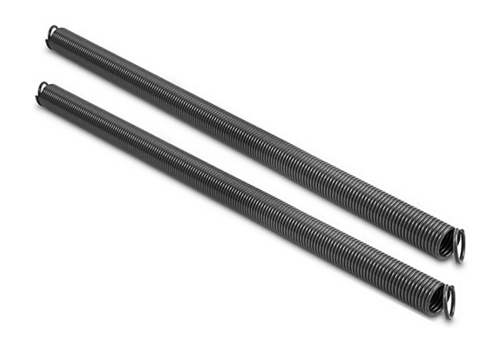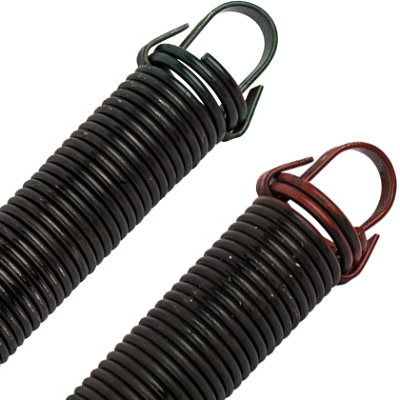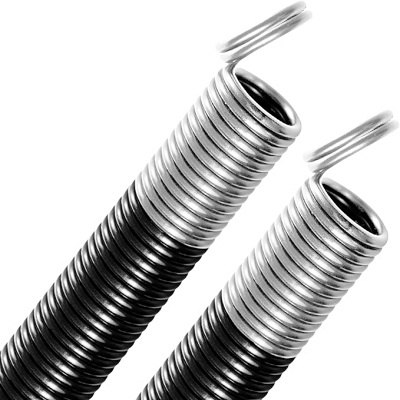Understanding Extension Garage Door Springs
At A Better Garage Door, we know that many homeowners don’t think much about their garage door until something goes wrong. But one of the most important components of a functional garage door system is the springs. These heavy-duty mechanisms are responsible for counterbalancing the weight of the door, making it possible to lift it smoothly and safely. In this article, we’ll take a closer look at one specific type – extension garage door springs – and explain how they work, how they compare to other types, and what to know if yours need service or replacement.
What Are Extension Springs?
Extension springs are long, coiled springs that are mounted on either side of the garage door, typically running parallel to the horizontal tracks. They work by extending and contracting as the door moves. When the garage door is closed, these springs are stretched out under tension. As the door opens, the tension is released, and the springs contract, helping to lift the door.
Extension springs • stretch and contract along the sides of your garage door to help lift and lower it. Extension springs work by stretching out as the door shuts and pulling it back up as it opens.
This mechanism relies on stored energy. Extension springs absorb energy when the door is lowered and release it when the door is raised. Because of their high-tension operation, they’re often paired with safety cables that prevent injury or damage in the event of a break.
Extension Springs vs. Torsion Springs
Garage doors rely on either extension springs or torsion springs to counterbalance the door's weight. Torsion springs are mounted horizontally above the door opening, while extension springs are installed on both sides of the door along the tracks. Although both serve the same basic purpose – to make lifting the door easier – they function quite differently and offer distinct advantages depending on your garage door setup and usage needs.
Torsion springs • tightly wound coils that sit above the garage door and twist to store energy as the door opens and closes. Torsion springs help raise your garage door by unwinding slowly and evenly, reducing bounce and sudden movement.


Extension springs operate by stretching and contracting, while torsion springs rotate around a shaft to apply torque. In some systems, both types may be used together to enhance support or accommodate specific door designs, but most residential setups use one or the other. At A Better Garage Door, we install and service both types based on the needs of your garage door system and your preferences as a homeowner.
| Attribute | Extension Springs | Torsion Springs |
|---|---|---|
| Location | Alongside horizontal tracks | Mounted above the door |
| Operation | Stretches and contracts | Twists to store torque |
| Cost | Lower initial cost | Higher upfront cost |
| Lifespan | 5,000-10,000 cycles | 15,000-20,000 cycles |
| Performance | More bounce and sway | Smoother, more controlled |
| Safety | Requires safety cables | Less likely to snap dangerously |
Each spring type has its place, and our team at A Better Garage Door will always assess your door type and usage habits before recommending the best solution. While torsion springs offer superior performance and longevity, extension springs are still a viable, cost-effective option for many homeowners.
Types of Extension Springs
Extension springs come in several variations, each designed to meet specific load requirements and garage door setups. While they all perform the same basic function—extending and contracting to support the door’s weight—their construction and performance characteristics can differ significantly. Choosing the right type of extension spring is crucial for ensuring safe, balanced operation and long-term reliability.
The most common types of extension springs used in residential garage doors include open-looped, double-looped, and clipped-end springs. These classifications refer to the shape and strength of the connection at each end of the spring, where it attaches to other components of the garage door system. The right choice depends on your garage door's weight, usage frequency, and durability needs. At A Better Garage Door, we carefully evaluate each installation or repair to ensure the correct type of extension spring is selected.
| Type | End Style | Strength | Durability | Installation Complexity | Common Usage |
|---|---|---|---|---|---|
| Open-Looped | Single wire looped at the end | Low | Basic | Easy to install | Lightweight garage doors |
| Double-Looped | Two coils forming the end loop | Medium | Moderate | Moderate difficulty | Standard residential garage doors |
| Clipped-End | Metal clip fastened to the end | High | Most durable | Challenging to install | Heavy or high-cycle garage doors |
Open-looped springs are cost-effective and simple to replace, making them ideal for lighter doors. Double-looped springs offer more strength and durability for average residential use. Clipped-end springs are the most robust and best suited for heavier doors or higher usage demands, often seen in larger homes or small commercial spaces.
If you're unsure which type your garage door system uses or needs, our technicians at A Better Garage Door can inspect your current setup and recommend the best solution based on safety, performance, and cost-efficiency.
Common Problems with Extension Springs
Like any mechanical component, extension springs are prone to wear and tear. Over time, the metal can weaken, corrode, or break – especially in Colorado’s fluctuating weather conditions. If your garage door begins to feel heavy, operates unevenly, or jerks while moving, the extension springs may be to blame.
Other signs of trouble include:
- Springs that are overstretched or distorted
- Unusual noises like popping or banging when opening the door
- Broken or frayed safety cables
If any of these issues arise, do not attempt to repair or replace the springs yourself. These high-tension components can cause serious injury if mishandled. Our trained professionals have the tools and experience to handle spring repairs safely and effectively.
Replacing or Upgrading Extension Springs
Extension springs generally last about 7–10 years, depending on usage. If your springs are nearing the end of their life, it may be time to consider replacement. When selecting new springs, it’s critical to match them with your garage door’s weight and dimensions. Mismatched springs can lead to poor operation or premature failure.
At A Better Garage Door, we take precise measurements and only use high-quality springs built to industry standards. In some cases, homeowners choose to upgrade from extension to torsion springs for improved performance, especially if their garage door system is older or experiencing chronic issues.
"When properly installed, your springs can last approximately 10,000 cycles. One cycle includes both the opening and closing of the door.
Technically speaking, your springs should last between 7 to 10 years. However, this depends on how often you use your garage door. Many people use their garage as a front door. This will shorten that lifespan considerably."
SOURCE: Overhead Garage Doors
Whether you’re looking to replace your current springs or want to explore upgrading to a more efficient system, our experts will walk you through your options and make sure your door is working at its best.
Safety Tips and Professional Maintenance
Because extension springs are under high tension, safety is a top concern. Always check for safety cables running through the center of the springs – these are designed to contain the spring if it breaks. If your system lacks them, we strongly recommend having them installed as soon as possible.
Need Overhead Door Repairs?
Visit the page below to learn more about the overhead door repair services we offer – or call our team for a free estimate!Routine inspections are essential to keeping your garage door safe and functional. Here are a few tips to extend the life of your extension springs:
- Visual inspections – Check springs for rust, stretching, or separation.
- Lubrication – Use a silicone-based spray to prevent corrosion and reduce friction.
- Balance testing – Periodically disconnect the opener and lift the door manually. If it doesn’t stay balanced mid-way, the springs may be worn.
- Annual servicing – Have a professional technician inspect the springs and other components at least once a year.
Our team at A Better Garage Door is always available for maintenance and tune-ups. Regular care not only improves safety – it also extends the lifespan of your entire garage door system.
Conclusion
Extension garage door springs may not be the flashiest part of your garage door, but they’re absolutely essential to its operation. Whether you’re opening your door to head to work or closing it at night for peace of mind, your springs are doing the heavy lifting behind the scenes. Understanding how they work, what sets them apart from torsion springs, and how to spot potential issues can help you stay ahead of problems and ensure long-term reliability.
At A Better Garage Door, we’re proud to serve Colorado homeowners with expert garage door repair, installation, and maintenance. If you’re dealing with a broken spring or want to learn more about your options, give us a call – we’re here to help.


